Agency: Courts Line Item: Administration Function The main Courts line item is Administration. It includes the Utah court system and related support services. The Utah court system consists of Appellate Courts, Trial Courts, and Justice Courts—funded and operated by local government—functioning under standards established by the Judicial Council. The Judicial Council, through the Administrative Office of the Courts, provides the administrative support for the judicial branch.
Intent Language Under Section 63J-1-603 of the Utah Code, the Legislature intends that appropriations provided for Administration in Item 19 of Chapter 2 Laws of Utah 2010 not lapse at the close of fiscal year 2011. It is the intent of the Legislature that the Bar Admissions Certification Dedicated Credits carry forward into FY 2012. The Legislature intends that agencies maximize budgets by examining expiring leases and contracts and explore all possibilities in doing so including re-negotiating for lower lease and contract rates, planning and allowing leases to expire and moving to locations with lower costs, purchasing instead of leasing a facility, and more. The Legislature intends to set the District Court Judge Salary at $132,150 for FY 2012. Special Funds 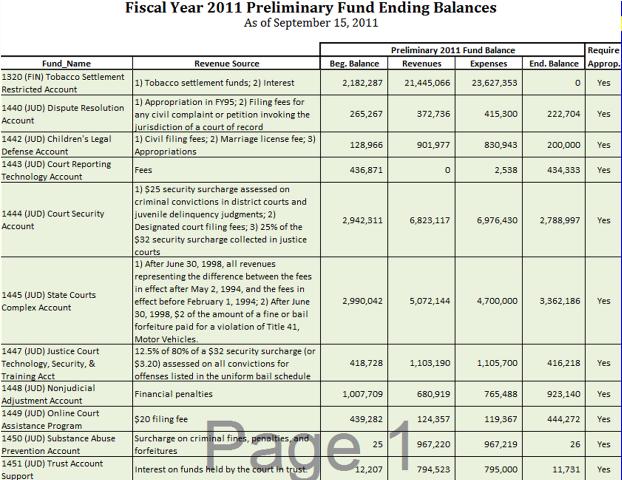 Funding Detail The table below details the funding and lists the programs in the Administration line item. Though there are numerous funding sources listed, 84 percent of the budget is from the General Fund. | Sources of Finance | 2008
Actual | 2009
Actual | 2010
Actual | 2011
Actual | 2012
Approp | | General Fund | $88,872,200 | $80,363,500 | $86,043,600 | $85,851,100 | $83,537,800 | | General Fund, One-time | $733,400 | $5,219,200 | ($2,185,600) | $42,500 | $200,000 | | Federal Funds | $273,400 | $624,900 | $490,200 | $227,900 | $326,700 | | Dedicated Credits Revenue | $1,369,900 | $1,741,700 | $3,656,700 | $1,661,000 | $2,931,100 | | GFR - Dispute Resolution | $310,700 | $317,500 | $590,000 | $415,300 | $414,300 | | GFR - Children's Legal Defense | $229,800 | $361,400 | $561,500 | $361,500 | $361,200 | | GFR - Court Reporter Technology | $0 | $250,000 | $250,000 | $250,000 | $250,000 | | GFR - Court Security Account | $4,756,400 | $5,106,400 | $7,556,400 | $7,556,400 | $7,556,400 | | GFR - Court Trust Interest | $250,000 | $775,000 | $775,000 | $795,000 | $795,000 | | GFR - DNA Specimen | $244,200 | $252,800 | $252,800 | $250,300 | $249,200 | | GFR - Justice Court Tech, Sec,& Training | $899,400 | $1,299,300 | $1,299,300 | $1,105,700 | $1,105,000 | | GFR - Non-Judicial Assessment | $721,700 | $1,445,300 | $1,154,100 | $936,200 | $932,100 | | GFR - Online Court Assistance | $74,400 | $75,000 | $251,000 | $201,000 | $251,000 | | GFR - State Court Complex | $0 | $300,000 | $300,000 | $300,000 | $300,000 | | GFR - Substance Abuse Prevention | $447,700 | $502,400 | $502,400 | $513,500 | $512,700 | | GFR - Tobacco Settlement | $193,700 | $193,700 | $352,800 | $352,800 | $352,800 | | GFR - Transcriptions | $250,000 | $0 | $0 | $0 | $0 | | Transfers | $0 | $152,000 | $830,800 | $130,800 | $0 | | Transfers - Commission on Criminal and Juvenile Justice | $551,900 | $554,700 | $903,500 | $729,500 | $576,500 | | Transfers - Human Services | $89,100 | $0 | $0 | $0 | $0 | | Transfers - Other Agencies | $658,300 | $0 | ($2,046,200) | $413,000 | $278,000 | | Transfers - Public Safety | $28,000 | $0 | $0 | $0 | $0 | | Transfers - Youth Corrections | $0 | $147,900 | $0 | $0 | $0 | | Beginning Nonlapsing | $1,256,900 | $1,708,500 | $1,329,200 | $2,008,100 | $0 | | Closing Nonlapsing | ($1,652,500) | ($1,329,300) | ($2,008,100) | ($2,359,000) | $0 | | Lapsing Balance | ($1,200,900) | ($1,482,600) | ($3,167,500) | ($1,305,300) | $0 | | Total | $99,357,700 | $98,579,300 | $97,691,900 | $100,437,300 | $100,929,800 |
|---|
| | Programs: | 2008
Actual | 2009
Actual | 2010
Actual | 2011
Actual | 2012
Approp | | Supreme Court | $2,394,900 | $2,512,600 | $2,445,700 | $2,443,300 | $2,501,500 | | Law Library | $772,600 | $771,900 | $671,200 | $699,400 | $716,200 | | Court of Appeals | $3,304,700 | $3,257,000 | $3,151,700 | $3,663,900 | $3,827,500 | | District Courts | $40,950,100 | $40,354,800 | $39,359,600 | $39,434,100 | $38,940,000 | | Juvenile Courts | $33,835,300 | $34,787,400 | $34,783,900 | $34,179,200 | $35,285,400 | | Justice Courts | $1,154,900 | $1,163,000 | $1,162,900 | $1,241,700 | $1,307,800 | | Courts Security | $3,995,600 | $5,095,400 | $7,071,300 | $6,976,400 | $7,556,000 | | Administrative Office | $4,349,600 | $3,718,000 | $1,855,600 | $4,654,900 | $4,237,300 | | Judicial Education | $653,900 | $678,000 | $481,100 | $381,600 | $523,000 | | Data Processing | $7,025,400 | $5,006,600 | $5,300,900 | $5,559,600 | $5,273,000 | | Grants Program | $920,700 | $1,234,600 | $1,408,000 | $1,203,200 | $762,100 | | Total | $99,357,700 | $98,579,300 | $97,691,900 | $100,437,300 | $100,929,800 |
|---|
| | Categories of Expenditure | 2008
Actual | 2009
Actual | 2010
Actual | 2011
Actual | 2012
Approp | | Personnel Services | $81,626,200 | $84,168,200 | $83,523,100 | $84,060,300 | $80,603,100 | | In-state Travel | $386,600 | $280,600 | $226,600 | $263,200 | $352,200 | | Out-of-state Travel | $231,200 | $184,000 | $92,900 | $76,900 | $196,300 | | Current Expense | $12,841,500 | $12,126,000 | $11,617,300 | $13,496,100 | $18,189,900 | | DP Current Expense | $2,600,100 | $1,589,400 | $1,613,700 | $2,076,500 | $1,097,900 | | DP Capital Outlay | $729,800 | $30,500 | $409,900 | $234,900 | $288,400 | | Capital Outlay | $156,000 | $100 | $12,600 | $68,600 | $7,000 | | Other Charges/Pass Thru | $786,300 | $200,500 | $195,800 | $160,800 | $195,000 | | Total | $99,357,700 | $98,579,300 | $97,691,900 | $100,437,300 | $100,929,800 |
|---|
| | Other Indicators | 2008
Actual | 2009
Actual | 2010
Actual | 2011
Actual | 2012
Approp | | Budgeted FTE | 1,186.0 | 1,147.0 | 1,140.8 | 1,014.8 | 1,118.4 | | Actual FTE | 1,034.5 | 1,010.4 | 985.3 | 953.4 | 0.0 | | Vehicles | 153 | 147 | 140 | 138 | 147 |
|
|
|
|
|
|
Subcommittee Table of ContentsProgram: Supreme Court Function The Utah Supreme Court is the highest state court and, as such, the court of last appeal in Utah. The Supreme Court is located in the Scott M. Matheson Courthouse. The Court hears appeals from capital and first degree felony cases and all District Court civil cases except for cases regarding domestic relations. The Supreme Court has jurisdiction over judgments of the Court of Appeals by writ of certiorari, constitutional and election questions, proceedings of the Judicial Conduct Commission, and lawyer discipline. Five justices sit on the Supreme Court for ten-year renewable terms. The justices elect a chief justice by majority vote to serve for four years, and an associate chief justice to serve for two years. The Supreme Court has original jurisdiction to answer questions of state law certified from Federal Courts and to issue extraordinary writs. The Supreme Court reviews formal administrative proceedings of the Public Service Commission, Tax Commission, School and Institutional Trust Lands Board of Trustees, Board of Oil, Gas, and Mining, and the State Engineer. The court adopts rules of civil and criminal procedure and rules of evidence used in state courts. The Supreme Court manages the appellate process and governs the practice of law, including admissions to practice law. Justices are assisted by law clerks, staff attorneys, a clerk of the court, and a staff of legal secretaries and deputy court clerks. Staff attorneys screen the cases and the Appellate Court Administrator is responsible for the court operations. Statutory Authority The Utah Supreme Court is established by the Utah State Constitution Article VIII, Sections 1 through 4 and the following sections of the Utah Code: Performance The Supreme Court is guided by various performance measures. One primary metric used to measure performance is the clearance rate - the number of cases processed versus the number of new cases that are submitted to the Court. Below is the clearance rate reported annually which shows a rate above 100% since CY 2007. 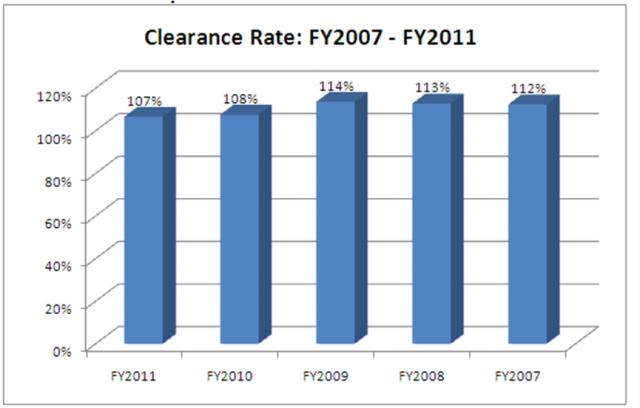 Funding Detail | Sources of Finance | 2008
Actual | 2009
Actual | 2010
Actual | 2011
Actual | 2012
Approp | | General Fund | $2,423,800 | $2,545,100 | $2,599,600 | $2,608,300 | $2,493,400 | | General Fund, One-time | $0 | $0 | ($18,400) | $0 | $0 | | Dedicated Credits Revenue | $0 | $0 | $0 | $0 | $8,100 | | Closing Nonlapsing | ($28,900) | ($32,500) | ($135,500) | ($165,000) | $0 | | Total | $2,394,900 | $2,512,600 | $2,445,700 | $2,443,300 | $2,501,500 |
|---|
| | Categories of Expenditure | 2008
Actual | 2009
Actual | 2010
Actual | 2011
Actual | 2012
Approp | | Personnel Services | $2,311,100 | $2,438,000 | $2,383,500 | $2,367,600 | $2,425,500 | | In-state Travel | $600 | $300 | $100 | $100 | $900 | | Out-of-state Travel | $3,600 | $4,200 | $900 | $1,900 | $2,500 | | Current Expense | $71,900 | $67,700 | $58,700 | $68,600 | $72,600 | | DP Current Expense | $7,700 | $2,400 | $2,500 | $5,100 | $0 | | Total | $2,394,900 | $2,512,600 | $2,445,700 | $2,443,300 | $2,501,500 |
|---|
| | Other Indicators | 2008
Actual | 2009
Actual | 2010
Actual | 2011
Actual | 2012
Approp | | Budgeted FTE | 27.0 | 27.0 | 27.0 | 26.6 | 25.0 | | Actual FTE | 21.6 | 22.0 | 21.5 | 19.9 | 0.0 |
|
|
|
|
|
|
Subcommittee Table of ContentsProgram: Law Library Function The State Law Library was created to serve the courts, the executive agencies, the Legislature, and the public. The Library is located in the Scott M. Matheson Courthouse and is open to the public. Legislative General Counsel, the Attorney General, and the Supreme Court Chief Justice serve as the Board of Control for the Library. Statutory Authority The State Law Library is a statutorily created entity under UCA 9-7 (301 through 312). The authorizing code is under the section for the State Department of Community and Economic Development's State Library. Funding Detail | Sources of Finance | 2008
Actual | 2009
Actual | 2010
Actual | 2011
Actual | 2012
Approp | | General Fund | $642,800 | $596,100 | $671,700 | $664,700 | $602,900 | | General Fund, One-time | $0 | $0 | ($2,600) | $0 | $0 | | Dedicated Credits Revenue | $120,300 | $122,100 | $143,800 | $177,200 | $113,300 | | Beginning Nonlapsing | $130,200 | $58,200 | $0 | $0 | $0 | | Closing Nonlapsing | ($120,700) | ($4,500) | ($141,700) | ($142,500) | $0 | | Total | $772,600 | $771,900 | $671,200 | $699,400 | $716,200 |
|---|
| | Categories of Expenditure | 2008
Actual | 2009
Actual | 2010
Actual | 2011
Actual | 2012
Approp | | Personnel Services | $307,200 | $314,000 | $354,300 | $391,400 | $361,000 | | In-state Travel | $0 | $600 | $400 | $300 | $100 | | Out-of-state Travel | $1,500 | $1,200 | $0 | $1,600 | $0 | | Current Expense | $457,600 | $455,000 | $316,000 | $303,400 | $355,100 | | DP Current Expense | $6,300 | $1,100 | $500 | $2,700 | $0 | | Total | $772,600 | $771,900 | $671,200 | $699,400 | $716,200 |
|---|
| | Other Indicators | 2008
Actual | 2009
Actual | 2010
Actual | 2011
Actual | 2012
Approp | | Budgeted FTE | 4.0 | 5.0 | 5.0 | 4.9 | 5.0 | | Actual FTE | 4.6 | 4.0 | 5.0 | 4.7 | 0.0 |
|
|
|
|
|
|
Subcommittee Table of ContentsProgram: Court of Appeals Function The jurisdiction of the Court of Appeals is complementary to the Utah Supreme Court, and is also located in the Scott M. Matheson Courthouse. The Court of Appeals hears all appeals from the Juvenile Court as well as appeals from the District Court involving domestic relations cases, divorce, annulment, property division, child custody, support, visitation, adoption, paternity, and criminal matters of less than a first degree. The court reviews appeals of formal administrative proceedings by state agencies, with a few exceptions. The Court of Appeals also has jurisdiction to hear cases transferred to it by the Supreme Court. Background The Utah Court of Appeals was created in 1987. It consists of seven judges who serve six-year, renewable terms. A presiding judge is elected by a majority vote of the Appellate judges to serve for two years. The judges are assisted by the clerk of the court, central staff attorneys, law clerks, legal secretaries, and deputy court clerks. Statutory Authority UCA 78A-1-101 establishes the Court of Appeals. Performance The clearance rate for cases processed versus those submitted to the Court of Appeals is depicted below. Currently, more cases are being submitted to this court than are being processed. This increase in FY 2011 in clearance rate is due in part to a filled vacancy in the Court of Appeals. 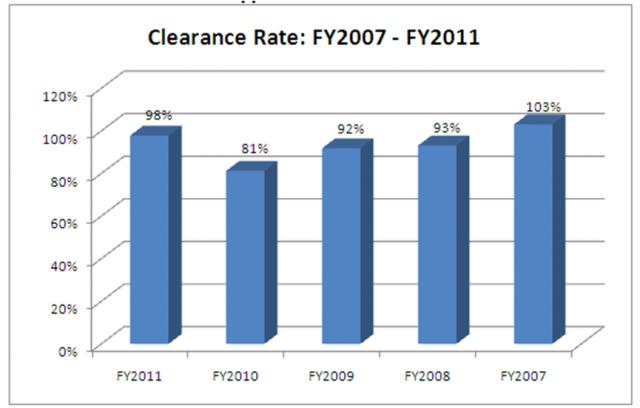 Funding Detail | Sources of Finance | 2008
Actual | 2009
Actual | 2010
Actual | 2011
Actual | 2012
Approp | | General Fund | $3,356,000 | $3,338,300 | $3,706,900 | $3,719,800 | $3,827,500 | | General Fund, One-time | $0 | $0 | ($26,100) | $0 | $0 | | Closing Nonlapsing | ($51,300) | ($81,300) | ($529,100) | ($55,900) | $0 | | Total | $3,304,700 | $3,257,000 | $3,151,700 | $3,663,900 | $3,827,500 |
|---|
| | Categories of Expenditure | 2008
Actual | 2009
Actual | 2010
Actual | 2011
Actual | 2012
Approp | | Personnel Services | $3,193,600 | $3,166,000 | $3,057,100 | $3,585,700 | $3,718,700 | | In-state Travel | $600 | $500 | $1,200 | $800 | $2,700 | | Out-of-state Travel | $3,000 | $2,900 | $1,000 | $2,000 | $5,400 | | Current Expense | $102,600 | $82,400 | $85,600 | $70,400 | $100,700 | | DP Current Expense | $4,900 | $5,200 | $6,800 | $5,000 | $0 | | Total | $3,304,700 | $3,257,000 | $3,151,700 | $3,663,900 | $3,827,500 |
|---|
| | Other Indicators | 2008
Actual | 2009
Actual | 2010
Actual | 2011
Actual | 2012
Approp | | Budgeted FTE | 36.0 | 36.0 | 36.0 | 35.3 | 36.0 | | Actual FTE | 27.4 | 25.5 | 25.7 | 27.1 | 0.0 |
|
|
|
|
|
|
Subcommittee Table of ContentsProgram: District Courts Function The District Court has original jurisdiction to hear civil cases, criminal felonies, and Class A misdemeanors. Civil cases include, but are not limited to, contracts, torts, and property cases. Criminal cases heard in the district court include offenses such as homicides, assaults, drug and sex offenses, forgery, arson, robbery, and driving under the influence. The District Court may also hear class B and C misdemeanors when a city justice court is unavailable. District Courts hear domestic relations cases, such as divorces, child custody, child support, adoptions, and probate. District judges have the power to issue warrants, subpoenas, and ex parte protective orders. In addition, the court serves as an appellate court to review informal adjudicative proceedings from administrative agencies and de novo review of justice court appeals. Judicial Support : Each district judge has a deputy court clerk to assist the judge in scheduling hearings and pre-trial conferences and handle the day-to-day business of the district court. Judges have a bailiff available during any court proceeding where it is deemed necessary by the judge. Either a court reporter or an electronic recording device is provided to maintain a record of all court proceedings. In the more populous districts, domestic court commissioners assist district judges by conducting pre-trial domestic hearings, pursuing settlements, entering temporary orders and making final recommendations to the judges in domestic relations cases. If a party disagrees with a court commissioner's recommendation, a hearing may be requested before a judge. In some districts, court referees are available to assist in the resolution of traffic cases. Small Claims: The District Courts have a small claims department, which covers disputes under $7,500. A district judge may hear small claims cases, but typically a judge pro tempore hears such cases. In areas where a judge pro tempore has not been assigned, the district judge may transfer a small claims case to a justice court. Any individual or business may use small claims court. Statutory Authority The District Courts is governed by UCA 78A-5. Performance The District Courts employ several performance metrics. Measures include clearance rates, time to case disposition, and age of active pending cases. One primary measure of performance for the State District Courts is the clearance rate. This metric measures the rate at which the Courts dispose of a case versus the number of cases that are filed. A clearance rate greater than 100% translates into a reduction in the Courts' case pending counts. A rate below 100% means that fewer cases are being closed than are being opened. Below are the clearance rates for certain types of cases within the District Courts. Criminal cases typically take longer to process than all other types of cases. 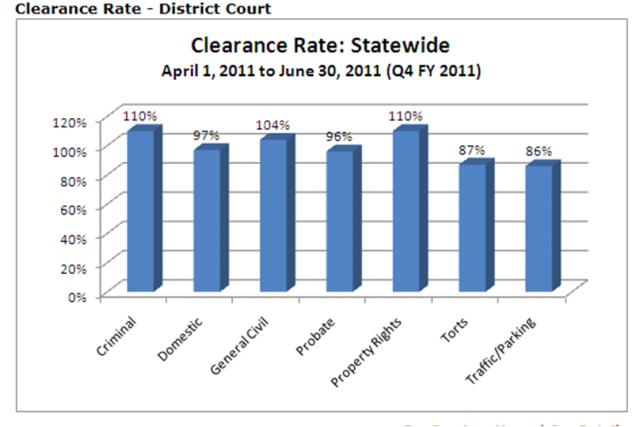 Time to disposition is the the time taken to complete or dispose of court cases. Included below are FY 2011 measurements. 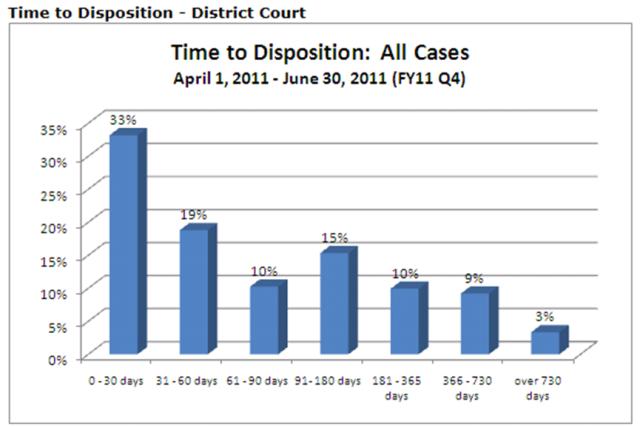 The measurement of the age of active pending cases counts the number of pending court cases and the length of time they have been pending. 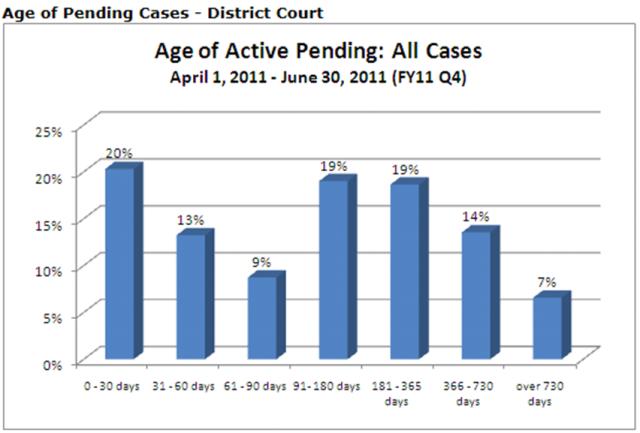 Funding Detail | Sources of Finance | 2008
Actual | 2009
Actual | 2010
Actual | 2011
Actual | 2012
Approp | | General Fund | $39,196,400 | $31,974,200 | $39,573,300 | $37,761,400 | $36,261,600 | | General Fund, One-time | $379,400 | $6,200,100 | ($2,311,700) | $38,500 | $0 | | Federal Funds | $0 | $0 | $0 | $0 | $100,000 | | Dedicated Credits Revenue | $43,800 | $665,700 | $536,800 | $159,400 | $776,400 | | GFR - Dispute Resolution | $19,900 | $19,900 | $292,400 | $117,700 | $117,700 | | GFR - Children's Legal Defense | $229,800 | $361,400 | $561,500 | $361,500 | $361,200 | | GFR - Court Reporter Technology | $0 | $250,000 | $250,000 | $250,000 | $250,000 | | GFR - Court Trust Interest | $0 | $525,000 | $525,000 | $545,000 | $545,000 | | GFR - State Court Complex | $0 | $300,000 | $300,000 | $300,000 | $300,000 | | GFR - Substance Abuse Prevention | $0 | $7,700 | $13,800 | $13,800 | $13,800 | | GFR - Tobacco Settlement | $0 | $0 | $83,300 | $83,300 | $83,300 | | GFR - Transcriptions | $250,000 | $0 | $0 | $0 | $0 | | Transfers | $0 | $152,000 | $0 | $130,800 | $0 | | Transfers - Human Services | $89,100 | $0 | $0 | $0 | $0 | | Transfers - Other Agencies | $506,900 | $0 | $181,200 | $0 | $131,000 | | Beginning Nonlapsing | $764,400 | $367,400 | $0 | $498,600 | $0 | | Closing Nonlapsing | ($367,900) | ($315,200) | ($401,000) | ($578,400) | $0 | | Lapsing Balance | ($161,700) | ($153,400) | ($245,000) | ($247,500) | $0 | | Total | $40,950,100 | $40,354,800 | $39,359,600 | $39,434,100 | $38,940,000 |
|---|
| | Categories of Expenditure | 2008
Actual | 2009
Actual | 2010
Actual | 2011
Actual | 2012
Approp | | Personnel Services | $37,728,100 | $38,016,100 | $37,026,900 | $38,074,700 | $34,270,000 | | In-state Travel | $152,300 | $118,000 | $73,900 | $86,900 | $140,700 | | Out-of-state Travel | $20,900 | $18,300 | $5,100 | $2,600 | $8,500 | | Current Expense | $2,524,700 | $2,159,800 | $2,166,500 | $1,193,200 | $4,520,800 | | DP Current Expense | $101,100 | $42,600 | $83,700 | $75,900 | $0 | | Capital Outlay | $5,400 | $0 | $3,100 | $0 | $0 | | Other Charges/Pass Thru | $417,600 | $0 | $400 | $800 | $0 | | Total | $40,950,100 | $40,354,800 | $39,359,600 | $39,434,100 | $38,940,000 |
|---|
| | Other Indicators | 2008
Actual | 2009
Actual | 2010
Actual | 2011
Actual | 2012
Approp | | Budgeted FTE | 551.0 | 500.0 | 512.9 | 406.7 | 500.9 | | Actual FTE | 460.7 | 441.1 | 424.3 | 413.6 | 0.0 | | Vehicles | 45 | 45 | 42 | 42 | 45 |
|
|
|
|
|
|
Subcommittee Table of ContentsProgram: Juvenile Courts Function The Juvenile Court has jurisdiction over youth, less than 18 years of age, who violate federal, state, or municipal law. The Juvenile Courts also have responsibility for any child who is abused, neglected, or dependent. The court has the power to determine child custody, support, and visitation. It can permanently terminate parental rights, and authorize or require treatment for children with psychological or developmental problems. The court can place children in probation supervision, custody, foster homes, group homes, special treatment centers, or secure institutions. The Office of Guardian ad Litem appears in Juvenile Court on cases involving abuse, neglect, or dependency. Juvenile Courts can require juveniles to pay fines, and make restitution for damage and loss resulting from delinquent acts. The court has jurisdiction over habitual truants, runaways, and ungovernable youth—if efforts by other social service agencies are not successful. In addition, the court has exclusive jurisdiction in traffic offenses involving minors related to automobile homicide, driving under the influence of alcohol or drugs, reckless driving, joy riding, or fleeing a police officer. Juvenile Court has concurrent jurisdiction with the District and Justice Courts over adults contributing to the delinquency and neglect of a minor and lesser traffic matters. The Juvenile Court, unlike other state courts of record, administers a probation department. Probation officers prepare dispositional reports, supervise youth who have been placed on probation by the court, conduct evaluations, and submit reports on the progress of each juvenile. Background Judicial Districts There are 29 juvenile court judges and 1.5 commissioners in the state's eight judicial districts. Interstate Compact As a member of the Interstate Compact on Juveniles, the court accepts supervision of juveniles who move to Utah from other states (who were under court supervision before moving). In turn, the court often requests other states to supervise juveniles who move while still under court supervision in Utah. Statutory Authority The entire chapter of Utah Code 78A-6 outlines the jurisdiction, responsibilities and procedures for the Juvenile Court. Performance According to the Courts, a key indicator of juvenile delinquency
is the per capita rate of delinquency referrals. This metric analyzes the number of delinquency referrals for youth 10 to 17 years of age per 1,000 members of the Utah population 10 to 17 years of age. Compared to FY 2008-09, FY 2010 exhibits lower referral rates for juvenile offenders. 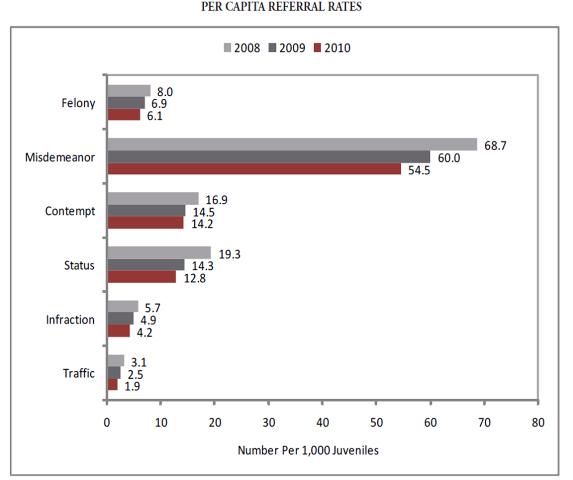 Funding Detail | Sources of Finance | 2008
Actual | 2009
Actual | 2010
Actual | 2011
Actual | 2012
Approp | | General Fund | $32,043,100 | $31,913,800 | $31,160,900 | $32,877,600 | $31,946,700 | | General Fund, One-time | $0 | $0 | ($204,500) | $0 | $0 | | Federal Funds | $0 | $0 | $40,700 | $40,600 | $40,600 | | Dedicated Credits Revenue | $633,900 | $1,000,700 | $1,092,000 | $534,700 | $1,051,800 | | GFR - Dispute Resolution | $290,800 | $297,600 | $297,600 | $297,600 | $296,600 | | GFR - DNA Specimen | $244,200 | $252,800 | $252,800 | $250,300 | $249,200 | | GFR - Non-Judicial Assessment | $721,700 | $1,445,300 | $1,154,100 | $936,200 | $932,100 | | GFR - Substance Abuse Prevention | $447,700 | $494,700 | $488,600 | $499,700 | $498,900 | | GFR - Tobacco Settlement | $193,700 | $193,700 | $269,500 | $269,500 | $269,500 | | Transfers | $0 | $0 | $830,800 | $0 | $0 | | Beginning Nonlapsing | $217,500 | $279,900 | $0 | $257,300 | $0 | | Closing Nonlapsing | ($767,400) | ($339,700) | ($276,200) | ($1,388,100) | $0 | | Lapsing Balance | ($189,900) | ($751,400) | ($322,400) | ($396,200) | $0 | | Total | $33,835,300 | $34,787,400 | $34,783,900 | $34,179,200 | $35,285,400 |
|---|
| | Categories of Expenditure | 2008
Actual | 2009
Actual | 2010
Actual | 2011
Actual | 2012
Approp | | Personnel Services | $30,480,200 | $31,727,800 | $32,729,400 | $31,466,900 | $31,864,600 | | In-state Travel | $85,800 | $45,500 | $34,700 | $39,400 | $73,900 | | Out-of-state Travel | $16,600 | $5,500 | $500 | $1,800 | $4,800 | | Current Expense | $3,188,200 | $2,968,400 | $1,968,400 | $2,571,600 | $3,342,100 | | DP Current Expense | $41,700 | $40,100 | $41,400 | $99,500 | $0 | | Capital Outlay | $22,800 | $0 | $9,500 | $0 | $0 | | Other Charges/Pass Thru | $0 | $100 | $0 | $0 | $0 | | Total | $33,835,300 | $34,787,400 | $34,783,900 | $34,179,200 | $35,285,400 |
|---|
| | Other Indicators | 2008
Actual | 2009
Actual | 2010
Actual | 2011
Actual | 2012
Approp | | Budgeted FTE | 474.0 | 481.0 | 461.7 | 452.4 | 456.3 | | Actual FTE | 430.2 | 424.9 | 414.2 | 407.2 | 0.0 | | Vehicles | 100 | 93 | 89 | 87 | 93 |
|
|
|
|
|
|
Subcommittee Table of ContentsProgram: Justice Courts Function With oversight from the State Courts, local Justice Courts share jurisdiction with the Juvenile Court in cases involving 16 and 17 year old minors who are charged with certain traffic offenses. The Juvenile Court handles automobile homicide, alcohol or drug related traffic offenses, reckless driving, fleeing an officer, and driving on a suspended license. When requested, four-member juries hear cases in the Justice Courts. City attorneys prosecute cases involving municipal ordinance violations and state law in municipal courts; county attorneys prosecute cases involving violations of county ordinances and state law in the county courts. Litigants and defendants often act without an attorney (pro se) in Justice Courts. Any person not satisfied with a judgment rendered in a Justice Court is entitled to a trial de novo (new trial) in the District Court. Any Justice Court judge may be appointed by the presiding District Court judge to conduct preliminary examinations and arraignments for felony cases under some circumstances. Justice Courts also have a Small Claims Department, which has jurisdiction over claims under $7,500. Background Justice Courts are established by counties and municipalities and have the authority to deal with class B and C misdemeanors, violations of ordinances, small claims, and infractions committed within their territorial jurisdiction. Justice Courts hear the vast majority of cases in Utah, and fulfill the constitutional obligation of a court not of record. Justice Court territorial jurisdiction is determined by the boundaries of local government entities such as cities or counties, which hire the judges. Justice Court judges are nominated by local nominating commissions, and selected by the local government entity. They serve six-year terms of office, and stand for retention elections. Judges in large jurisdictions may hear cases daily while others hold court once a month. Justice Court judges need not be attorneys, although they receive extensive and continuing legal training. All Justice Court judges must receive 30 hours of continuing judicial education each year to remain certified. There are 109 Justice Court judges serving in counties and cities throughout the state. Statutory Authority Justice Courts are specifically provided for in Article VIII of the Utah Constitution and in UCA 78A-7 including the jurisdiction of judges, judge qualifications, and terms of office. Performance Below is is the aggregate clearance rate for local justice courts. Currently, the clearance rate for all categories of cases processed in the justice courts is above 100% for the past four quarters. This is an improvement from recent years which show clearance rates below 100% prior to FY 2010. 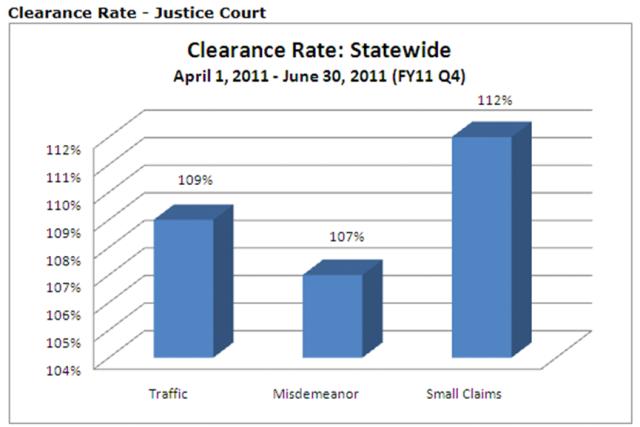 Funding Detail Funding support for the Justice Courts is primarily for training of judges and reporting of case adjudication. | Sources of Finance | 2008
Actual | 2009
Actual | 2010
Actual | 2011
Actual | 2012
Approp | | General Fund | $175,200 | $238,900 | $240,800 | $206,900 | $202,800 | | General Fund, One-time | $0 | $0 | ($1,600) | $0 | $0 | | GFR - Justice Court Tech, Sec,& Training | $899,400 | $999,300 | $1,299,300 | $1,105,700 | $1,105,000 | | Closing Nonlapsing | $148,800 | ($75,200) | ($375,600) | ($70,900) | $0 | | Lapsing Balance | ($68,500) | $0 | $0 | $0 | $0 | | Total | $1,154,900 | $1,163,000 | $1,162,900 | $1,241,700 | $1,307,800 |
|---|
| | Categories of Expenditure | 2008
Actual | 2009
Actual | 2010
Actual | 2011
Actual | 2012
Approp | | Personnel Services | $403,600 | $730,300 | $765,400 | $821,600 | $716,000 | | In-state Travel | $27,800 | $26,000 | $28,200 | $34,300 | $30,000 | | Out-of-state Travel | $30,700 | $18,700 | $15,900 | $10,600 | $0 | | Current Expense | $134,600 | $115,300 | $69,700 | $183,900 | $269,600 | | DP Current Expense | $399,500 | $272,700 | $248,500 | $191,300 | $252,000 | | DP Capital Outlay | $0 | $0 | $35,200 | $0 | $40,200 | | Other Charges/Pass Thru | $158,700 | $0 | $0 | $0 | $0 | | Total | $1,154,900 | $1,163,000 | $1,162,900 | $1,241,700 | $1,307,800 |
|---|
| | Other Indicators | 2008
Actual | 2009
Actual | 2010
Actual | 2011
Actual | 2012
Approp | | Budgeted FTE | 3.0 | 7.0 | 13.0 | 12.7 | 12.5 | | Actual FTE | 4.5 | 9.8 | 9.5 | 9.9 | 0.0 |
|
|
|
|
|
|
Subcommittee Table of ContentsProgram: Courts Security Function The Court Security program pays the expenses for bailiffs and other security personnel in the court room. In the 2009 General Session, the Legislature included perimeter security in this account paid out of restricted funds. Special Funds The Court Security Account provides the sole source of state funding for in-court security. Funding Detail Prior to FY 2004, bailiff services were funded with a General Fund appropriation. Legislation passed in the 2003 General Session instituted a security fee to fund bailiff services in the District Court. During the 2004 General Session additional funding was provided to fund the Juvenile Court. | Sources of Finance | 2008
Actual | 2009
Actual | 2010
Actual | 2011
Actual | 2012
Approp | | General Fund | $0 | $0 | $700 | $0 | ($400) | | General Fund, One-time | $0 | $0 | ($700) | $0 | $0 | | GFR - Court Security Account | $4,756,400 | $5,106,400 | $7,556,400 | $7,556,400 | $7,556,400 | | Closing Nonlapsing | $900 | $537,600 | $0 | $0 | $0 | | Lapsing Balance | ($761,700) | ($548,600) | ($485,100) | ($580,000) | $0 | | Total | $3,995,600 | $5,095,400 | $7,071,300 | $6,976,400 | $7,556,000 |
|---|
| | Categories of Expenditure | 2008
Actual | 2009
Actual | 2010
Actual | 2011
Actual | 2012
Approp | | Personnel Services | $86,800 | $495,200 | $94,100 | $95,300 | $95,200 | | In-state Travel | $300 | $100 | $300 | $900 | $0 | | Current Expense | $3,908,500 | $4,600,000 | $6,976,900 | $6,880,200 | $7,460,800 | | Capital Outlay | $0 | $100 | $0 | $0 | $0 | | Total | $3,995,600 | $5,095,400 | $7,071,300 | $6,976,400 | $7,556,000 |
|---|
| | Other Indicators | 2008
Actual | 2009
Actual | 2010
Actual | 2011
Actual | 2012
Approp | | Budgeted FTE | 1.0 | 1.0 | 1.0 | 1.0 | 1.0 | | Actual FTE | 1.0 | 1.0 | 1.0 | 1.0 | 0.0 |
|
|
|
|
|
|
Subcommittee Table of ContentsProgram: Administrative Office Function The Administrative Office of the Courts (AOC) provides all support functions to the judicial branch under policy direction from the Judicial Council. The AOC includes all the support functions required to operate a corporate entity with a budget of approximately $130 million. Under the Judicial Council's direction, the State Court Administrator manages and directs the work of approximately 1,000 staff. The AOC is responsible for operation of court administrative functions, service delivery, program management, judicial and staff education, automated systems, and appellate and trial court administration. Statutory Authority The AOC has broad statutory authority, powers, duties and responsibilities to support and administer the activity of the judicial branch as found in Title 78A of the Utah Code. Funding Detail The table below details the funding and lists the programs in the Administration line item. Though there are numerous funding sources listed, 85 percent of the budget is from the General Fund. | Sources of Finance | 2008
Actual | 2009
Actual | 2010
Actual | 2011
Actual | 2012
Approp | | General Fund | $3,926,300 | $5,240,800 | $2,924,200 | $3,308,500 | $3,537,300 | | General Fund, One-time | $0 | ($980,900) | $406,400 | $0 | $200,000 | | Dedicated Credits Revenue | $126,700 | ($839,300) | $1,332,600 | $195,400 | $250,000 | | GFR - Court Trust Interest | $250,000 | $250,000 | $250,000 | $250,000 | $250,000 | | Transfers - Other Agencies | $0 | $0 | ($2,400,000) | $0 | $0 | | Transfers - Public Safety | $28,000 | $0 | $0 | $0 | $0 | | Beginning Nonlapsing | $155,000 | $962,000 | $1,320,200 | $957,800 | $0 | | Closing Nonlapsing | ($136,400) | ($914,600) | $18,200 | ($56,800) | $0 | | Lapsing Balance | $0 | $0 | ($1,996,000) | $0 | $0 | | Total | $4,349,600 | $3,718,000 | $1,855,600 | $4,654,900 | $4,237,300 |
|---|
| | Categories of Expenditure | 2008
Actual | 2009
Actual | 2010
Actual | 2011
Actual | 2012
Approp | | Personnel Services | $2,997,700 | $2,966,300 | $2,547,100 | $2,876,500 | $3,111,100 | | In-state Travel | $48,200 | $48,400 | $30,100 | $31,500 | $41,100 | | Out-of-state Travel | $42,600 | $34,900 | $13,600 | $12,300 | $26,500 | | Current Expense | $1,043,400 | $458,900 | ($936,000) | $1,082,000 | $863,600 | | DP Current Expense | $17,700 | $9,500 | $5,700 | $424,000 | $0 | | Capital Outlay | $0 | $0 | $0 | $68,600 | $0 | | Other Charges/Pass Thru | $200,000 | $200,000 | $195,100 | $160,000 | $195,000 | | Total | $4,349,600 | $3,718,000 | $1,855,600 | $4,654,900 | $4,237,300 |
|---|
| | Other Indicators | 2008
Actual | 2009
Actual | 2010
Actual | 2011
Actual | 2012
Approp | | Budgeted FTE | 38.0 | 38.0 | 31.7 | 31.1 | 31.7 | | Actual FTE | 36.0 | 36.1 | 31.8 | 30.4 | 0.0 | | Vehicles | 7 | 8 | 8 | 8 | 8 |
|
|
|
|
|
|
Subcommittee Table of ContentsProgram: Judicial Education Function The state court administrator is responsible for providing education and training opportunities to judicial branch personnel. Continuing education programs function under policy guidance from the Standing Committee on Judicial Branch Education. The AOC, through the Utah Judicial Institute, provides classes, workshops and conferences for all judicial and non-judicial staff throughout the year so that staff may achieve the required hours of annual education. Specialized orientation programs are provided for court staff, probation officers, pro tem judges, and state and justice court judges. Over 100 classes are offered annually for court staff. Conferences offering specialized training include the Annual Judicial Conference, Appellate, Juvenile, District, and Justice Court Conferences, Justice Court Clerks' Conferences, and the Annual Court Employees' Conference. Workshops include Legislative Updates for judges and court staff, probation officer safety training, Legal Institute for Justice Court Judges and ad hoc programs throughout the year. When available, funds are provided for judges to receive out-of-state training. The Utah Judicial Institute also provides training for Utah's certified court interpreters, and administers tests to certify court interpreters. Periodic training is also provided to Utah's Divorce Education providers, and pro tem small claims judges. Background Judicial Council rule requires that judges and commissioners receive 30 hours of in-service educational training and other staff members receive 20 hours of training annually. Education staff coordinates education programs for more than 1,000 state court employees and over 110 judges. Education staff also provide education services to justice courts which employ more than 350 staff and over 125 judges. Statutory Authority The authority for judicial education comes from the Utah Code and the Code of Judicial Administration. Funding Detail | Sources of Finance | 2008
Actual | 2009
Actual | 2010
Actual | 2011
Actual | 2012
Approp | | General Fund | $710,100 | $629,900 | $641,500 | $545,000 | $523,000 | | General Fund, One-time | $0 | $0 | ($2,200) | $0 | $0 | | Beginning Nonlapsing | ($56,200) | $41,000 | $9,000 | $9,000 | $0 | | Closing Nonlapsing | $0 | $7,100 | ($167,200) | ($172,400) | $0 | | Total | $653,900 | $678,000 | $481,100 | $381,600 | $523,000 |
|---|
| | Categories of Expenditure | 2008
Actual | 2009
Actual | 2010
Actual | 2011
Actual | 2012
Approp | | Personnel Services | $302,400 | $337,600 | $323,300 | $187,200 | $184,100 | | In-state Travel | $53,400 | $21,900 | $29,800 | $29,000 | $13,300 | | Out-of-state Travel | $42,100 | $39,300 | $4,700 | $10,600 | $91,500 | | Current Expense | $242,400 | $272,500 | $118,300 | $150,900 | $234,100 | | DP Current Expense | $3,600 | $6,700 | $5,000 | $3,900 | $0 | | Other Charges/Pass Thru | $10,000 | $0 | $0 | $0 | $0 | | Total | $653,900 | $678,000 | $481,100 | $381,600 | $523,000 |
|---|
| | Other Indicators | 2008
Actual | 2009
Actual | 2010
Actual | 2011
Actual | 2012
Approp | | Budgeted FTE | 4.0 | 5.0 | 6.0 | 5.9 | 5.0 | | Actual FTE | 4.3 | 4.6 | 3.3 | 3.1 | 0.0 |
|
|
|
|
|
|
Subcommittee Table of ContentsProgram: Data Processing Function Three automated systems process cases and maintain all official records for Appellate Courts, District Courts, and Juvenile Courts. The information systems contain over seven million records. In the District Court alone, there are over 1,200 internal users and approximately 640 external entities depend on electronic access to District Court records. Court information systems support an electronic data warehouse, courtroom audio, court video recording systems, Internet applications such as the Online Court Assistance Program for self-represented litigants, the court web page (http://www.utcourts.gov), records imaging, an interactive voice response system for self-service case status checks, and automated fine payment systems. A major update to the Juvenile Court information system is now operational. Electronic filing is also now available. Technology enables courts to efficiently and effectively accomplish their objectives. Several statutes and judicial rules have been enacted requiring 'computerized databases' of information to be collected, organized and maintained. Newly developed data processing systems have allowed for statewide online transactions such as online payments, case filings and others. Statutory Authority Authority comes from the following sections: - UCA 78A-2-110 authorizes the Judicial Council to maintain a computerized database containing information about all judicial boards.
- UCA 78A-2-501 establishes the online court assistance program.
- UCA 78-2-408 authorizes funds to be collected for court reporting and the upgrade of technology.
Funding Detail | Sources of Finance | 2008
Actual | 2009
Actual | 2010
Actual | 2011
Actual | 2012
Approp | | General Fund | $6,398,500 | $3,886,400 | $4,524,000 | $4,158,900 | $4,143,100 | | General Fund, One-time | $354,000 | $0 | ($24,200) | $4,000 | $0 | | Dedicated Credits Revenue | $393,700 | $737,500 | $496,500 | $543,700 | $731,900 | | GFR - Justice Court Tech, Sec,& Training | $0 | $300,000 | $0 | $0 | $0 | | GFR - Online Court Assistance | $74,400 | $75,000 | $251,000 | $201,000 | $251,000 | | Transfers - Commission on Criminal and Juvenile Justice | $1,200 | $0 | $0 | $172,600 | $0 | | Transfers - Other Agencies | $151,400 | $0 | $172,600 | $0 | $147,000 | | Transfers - Youth Corrections | $0 | $147,900 | $0 | $0 | $0 | | Beginning Nonlapsing | $0 | $0 | $0 | $285,400 | $0 | | Closing Nonlapsing | ($328,700) | ($111,000) | $0 | $275,600 | $0 | | Lapsing Balance | ($19,100) | ($29,200) | ($119,000) | ($81,600) | $0 | | Total | $7,025,400 | $5,006,600 | $5,300,900 | $5,559,600 | $5,273,000 |
|---|
| | Categories of Expenditure | 2008
Actual | 2009
Actual | 2010
Actual | 2011
Actual | 2012
Approp | | Personnel Services | $3,419,500 | $3,555,800 | $3,534,500 | $3,712,300 | $3,564,100 | | In-state Travel | $6,200 | $3,100 | $18,400 | $6,200 | $33,000 | | Out-of-state Travel | $13,100 | $3,700 | $2,300 | $1,300 | $18,300 | | Current Expense | $781,300 | $611,600 | $528,400 | $514,700 | $563,500 | | DP Current Expense | $1,948,600 | $801,900 | $866,100 | $1,090,200 | $845,900 | | DP Capital Outlay | $729,800 | $30,500 | $351,200 | $234,900 | $248,200 | | Capital Outlay | $126,900 | $0 | $0 | $0 | $0 | | Total | $7,025,400 | $5,006,600 | $5,300,900 | $5,559,600 | $5,273,000 |
|---|
| | Other Indicators | 2008
Actual | 2009
Actual | 2010
Actual | 2011
Actual | 2012
Approp | | Budgeted FTE | 38.0 | 38.0 | 39.0 | 38.2 | 38.0 | | Actual FTE | 37.2 | 35.3 | 37.7 | 36.5 | 0.0 | | Vehicles | 1 | 1 | 1 | 1 | 1 |
|
|
|
|
|
|
Subcommittee Table of ContentsProgram: Grants Program Function The Grants budget is designed to facilitate the coordination of grant-funded projects within the courts. These grants are related to specific programs within the courts or projects undertaken by the courts with federal assistance. Funding Detail Funding for this program area is entirely from non-General Fund sources. Federal funds are transferred through the Commission on Criminal and Juvenile Justice. | Sources of Finance | 2008
Actual | 2009
Actual | 2010
Actual | 2011
Actual | 2012
Approp | | General Fund | $0 | $0 | $0 | $0 | ($100) | | Federal Funds | $273,400 | $624,900 | $449,500 | $187,300 | $186,100 | | Dedicated Credits Revenue | $51,500 | $55,000 | $55,000 | $50,600 | ($400) | | Transfers - Commission on Criminal and Juvenile Justice | $550,700 | $554,700 | $903,500 | $556,900 | $576,500 | | Transfers - Other Agencies | $0 | $0 | $0 | $413,000 | $0 | | Beginning Nonlapsing | $46,000 | $0 | $0 | $0 | $0 | | Closing Nonlapsing | ($900) | $0 | $0 | ($4,600) | $0 | | Total | $920,700 | $1,234,600 | $1,408,000 | $1,203,200 | $762,100 |
|---|
| | Categories of Expenditure | 2008
Actual | 2009
Actual | 2010
Actual | 2011
Actual | 2012
Approp | | Personnel Services | $396,000 | $421,100 | $707,500 | $481,100 | $292,800 | | In-state Travel | $11,400 | $16,200 | $9,500 | $33,800 | $16,500 | | Out-of-state Travel | $57,100 | $55,300 | $48,900 | $32,200 | $38,800 | | Current Expense | $386,300 | $334,400 | $264,800 | $477,200 | $407,000 | | DP Current Expense | $69,000 | $407,200 | $353,500 | $178,900 | $0 | | DP Capital Outlay | $0 | $0 | $23,500 | $0 | $0 | | Capital Outlay | $900 | $0 | $0 | $0 | $7,000 | | Other Charges/Pass Thru | $0 | $400 | $300 | $0 | $0 | | Total | $920,700 | $1,234,600 | $1,408,000 | $1,203,200 | $762,100 |
|---|
| | Other Indicators | 2008
Actual | 2009
Actual | 2010
Actual | 2011
Actual | 2012
Approp | | Budgeted FTE | 10.0 | 9.0 | 7.5 | 0.0 | 7.0 | | Actual FTE | 6.8 | 6.1 | 11.4 | 0.0 | 0.0 |
|
|
|
|
|
|
Subcommittee Table of Contents
|







